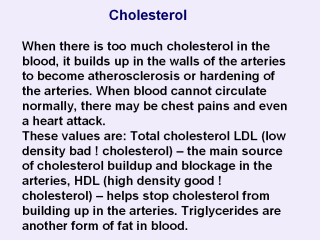| front |1 |2 |3 |4 |5 |6 |7 |8 |9 |10 |11 |12 |13 |14 |15 |16 |17 |18 |19 |20 |21 |22 |23 |24 |25 |review |
 |
If it is not possible to get a lipoprotein
profile done, knowing your total cholesterol and HDL cholesterol can give
you a general idea about your cholesterol levels. If your total cholesterol
is 200 mg/dL or more, or if your HDL is less than 40 mg/dL, you will need to
have a lipoprotein profile done. HDL, good cholesterol protects against heart disease, so for HDL; higher numbers are better. Less than 40 mg/dL is low. HDL levels of 60 mg/dL or more help to lower your risk of heart disease. Triglycerides can also raise heart disease risk. Levels that are borderline high (150-199 mg/dL) or high (200 mg/dL or more) may need treatment. Less than 200 mg/dL Desirable. 200-239 mg/dL Borderline high 240 mg/dL and above 240 is High Less than 100 mg/dL Optimal 100-129 mg/dL Near optimal/above optimal 130-159 mg/dL Borderline high 160-189 mg/dL High 190 mg/dL and above Very high. Hyperlipidemia is defined as abnormally high blood fat levels. Note that high blood pressure is over 140/90 mm Hg. |